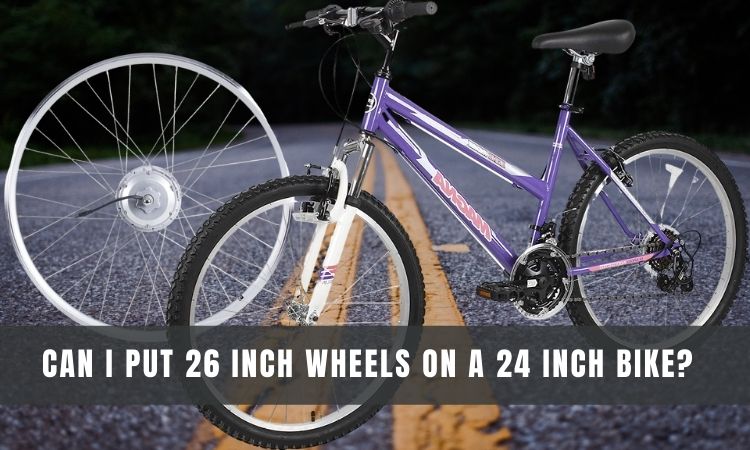Many bicycle enthusiasts often wonder if it’s possible to put larger wheels on a bike that originally came with smaller ones. In the case of a 24-inch bike, some people may contemplate whether it’s feasible to install 26-inch wheels instead.
This question arises due to various reasons such as availability of spare parts, desire for a different riding experience, or personal preference.
In this article, I will explore the feasibility of installing 26-inch wheels on a 24-inch bike and provide insights into the setup process. If you’re a curious cyclist or considering a modification to your bike, read on to discover the factors to consider and the steps involved in making this adjustment.
Can you put a 26 inch wheel on a 24 inch bike?
A 26 inch wheel on a 24 inch bike is an interesting combination. The larger wheel will make the bike easier to ride on rougher terrain and the smaller wheel will make the bike more maneuverable. Many 24-inch bike riders ask themselves that Can I put 26 inch wheels on a 24 inch bike?
The answer is yes, you can put 26 inch wheels on a 24 inch bike, but you cannot directly put a 26-inch wheel on a bike designed for 24-inch wheels. The size of the wheel is an essential factor in the overall geometry and functionality of a bicycle. Mixing wheel sizes that are not compatible can lead to various issues, including potential safety hazards and compromised performance.
The wheel size of a bike is determined by the frame design and fork clearance, which are specifically engineered to accommodate a particular wheel diameter. A 24-inch bike is designed to work optimally with 24-inch wheels, which means the frame and fork have been constructed with specific dimensions to fit that wheel size.
However, Lets know Difference between 24 and 26 inch bike and How to install 26-inch wheels on 24-inch bike if you want.

Difference between 24 and 26 inch bike
There are a few key differences between 24 and 26-inch bikes, the most noticeable being the size.
24 inch bike
- For starters, 24-inch bikes are typically designed for younger riders
- 24-inch bikes tend to have smaller wheels, which can make them easier to maneuver.
- 24-inch bikes typically have lower seat heights, making them more comfortable for shorter riders.
- The 24 inch bike is going to be slower and have a rougher ride than the 26 inch bike
- Finally, If you’re looking for a bike to ride around town, the 24 inch bike is a good choice
26 inch bike
- 26-inch bikes are better suited for adults and teens.
- The 26 inch bike is bigger and heavier, making it more difficult to ride and less maneuverable.
- The 26 inch bike is going to be faster and have a smoother ride.
- To make up for the larger diameter of the tires, 26-inch frames are typically lighter and stiffer. They can be critical considerations when traversing rough terrain or negotiating difficult obstacles like rocks on mountain bike models.
- When riding on slick or loose surfaces, 26-inch wheels may offer better traction because of their larger diameter.
- This allows them to maintain contact with the ground even when it is tilting during hard braking maneuvers, which is something many cyclists appreciate when commuting to work or competition in road races.
- If you’re looking for a bike to ride on trails or for racing, the 26 inch bike is a better choice.
How to Convert a 26-inch Wheel On a 24 inch Frame?
- A tire’s radius and air pressure should be measured to determine if your current wheel will fit.
- Fork and frame clearances should be measured as follows.
- To determine the fork’s size, find the smallest possible gap between the fork’s legs and the distance from the dropout to the crown’s lower wall.
- Take measurements of the frame’s dropouts and chain stays, as well as their narrowest gap. A chain stay bridge is needed if there isn’t one on the seat tube.
- To avoid wheel rubbing, subtract at least 5-8mm from all measurements. Compare the final numbers to the wheel’s diameter and radius.
- It’s not possible to use your current 26-inch wheels if the wheel size exceeds the findings.
- As a last resort, you could try using a smaller wheel and a narrower tire, such as a 1″ diameter model.
- In the event that this is not an option, you will either have to continue riding on 24′′ wheels or change the frame.
The Problems with Installing 26-inch Wheels on a 24-inch Bike
The combination still has some problems that are listed below:
1. Most Rim Brakes Won’t Work
Cantilever, V-brakes, and Mini V-brakes are attached to the brake bosses on the seat stays and forks of the bicycle.
Larger wheels require different boss positions, and this is because brakes need to grab the rim in order to work.
To accommodate smaller rims, 24-inch bicycles have lower brake mounts than 26-inch bicycles, which have higher brake mounts.
When you use a 26-inch wheel in a 24-inch fork or frame, the rim rises too high to allow the original brakes to be used.
There are a few options, but none of them are particularly easy to use.
The options are as follows:
V-brake Mount Risers
Special adapters that attach to the existing braze-ons and provide their own elevated brake spots can be used to raise the v-brake.
As a result of this design decision, the brake system has an additional point of failure.
V-brake Clamp Adapters
Installing V-brake adapters and positioning them at the proper height is another option.
Because of the high cost, this is a disadvantage. Clamp adapters can be expensive. USD 80-100 may be the cost for four. You can get a 26-inch rigid frame for the same price as a brand new one.
Cut and reweld the mounts
The brake pads on a 26-inch wheel can only grab the rim with the help of an experienced frame builder who removes the existing brake mounts and welds them higher on the frame and fork.
This isn’t the best solution in the real world because it could cost a lot of money to do it. You may be able to find a legitimate 26-inch frame for the same price or a little more on the second-hand market.
Switch to Caliper Brakes
In some cases, a pair of caliper (road) brakes can be installed on a bicycle’s frame and fork.
The drawback? Road wheels and tires in the 26-inch size are hard to come by because most are MTB-sized (7 speed or 29-inch).
The rear dropouts on an MTB frame are 135mm apart, so that’s another clue that the frame was originally intended for mountain biking. Rear road wheels have an O.L.D. of 130mm.
Consequently, you would need to cold set the frame to 130mm or purchase a custom 135mm wheel in order to fit.
2. Raised Bottom Bracket
Bikes with 26-inch wheels will have a higher center of gravity, which can cause them to be more difficult to control. Because mountain bikes have taller bottom brackets, the likelihood of experiencing this downside is greater with an MTB frame.
3. Severe Toe Overlap
These bikes are smaller and have shorter cranks as well as a smaller frame. Increasing the size of your wheels increases your risk of toe overlap, which is when your toes come into contact with the tire during a turn.
4. No Fender Clearance
Because there isn’t enough room for full fenders, it would be difficult to install them.
5. Unpleasant Geometry
However, the bike’s frame will remain the same if it has larger wheels. The rider may still feel restricted or constrained by the geometry.
What are the Drawbacks of 26 inch wheels?
26 inch wheels are becoming more and more popular in the cycling world, but there are many drawbacks to these wheels. For starters, 26 inch is not a standard size. It is an odd number so it does not work for mountain biking because the frame of the bike has to be specially made for this size.
Another drawback is that 26 inch wheels are heavier than most other sizes, which can make it difficult to pedal up hills with ease.
Can you put 26 inch wheels on a 27.5 frame?
A 26-inch wheel can be easily mounted on a 27.5-inch fork if both are disc brake ready, even if the frame and fork are large enough to accept a 26-inch wheel. Braze-ons would be a little higher, but rim brakes won’t catch on the fork if it uses them.
The geometry of the bike will be altered, but not significantly, by mounting a 26-inch wheel on a 27.5-inch fork. Adding a 26-inch wheel on the back will help minimize the changes.
Conclusion
While it is technically possible to fit 26-inch wheels on a 24-inch bike, the obstacles and costs involved are simply too great for most people to justify the effort.
If you really need 26-inch wheels, you should just buy a proper 26-inch frame instead of a fun little project to try out.



Pingback: How to shorten a bike chain within 10 minutes
Pingback: Can I put 27.5 wheels on a 26 bike ?